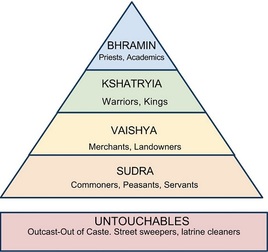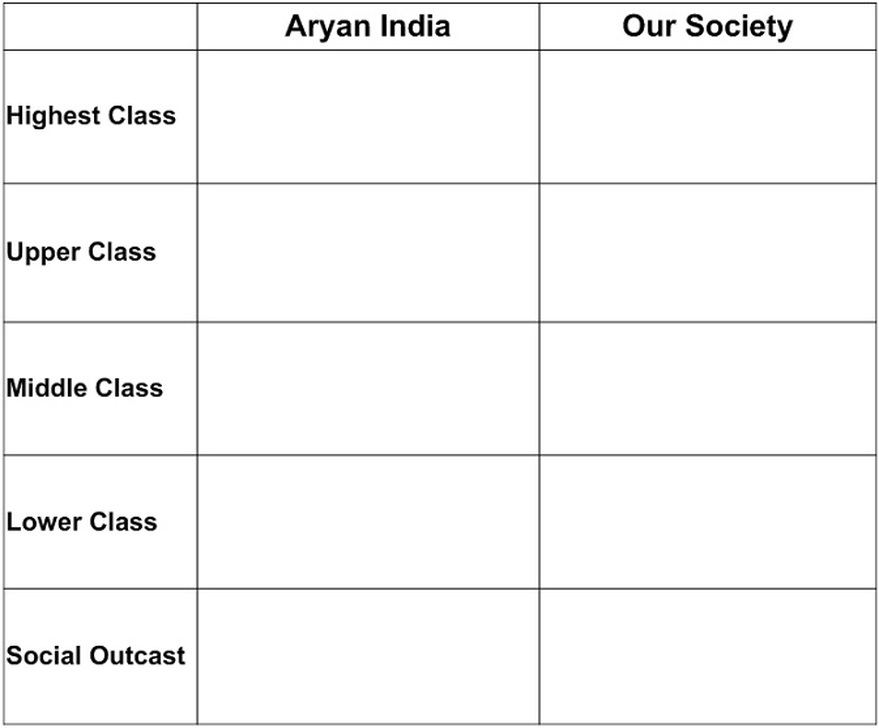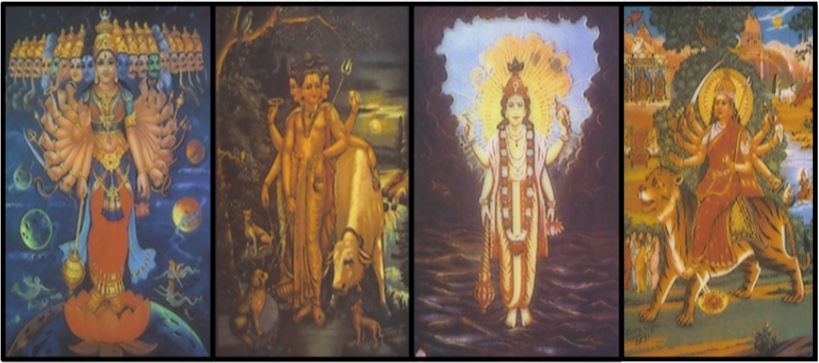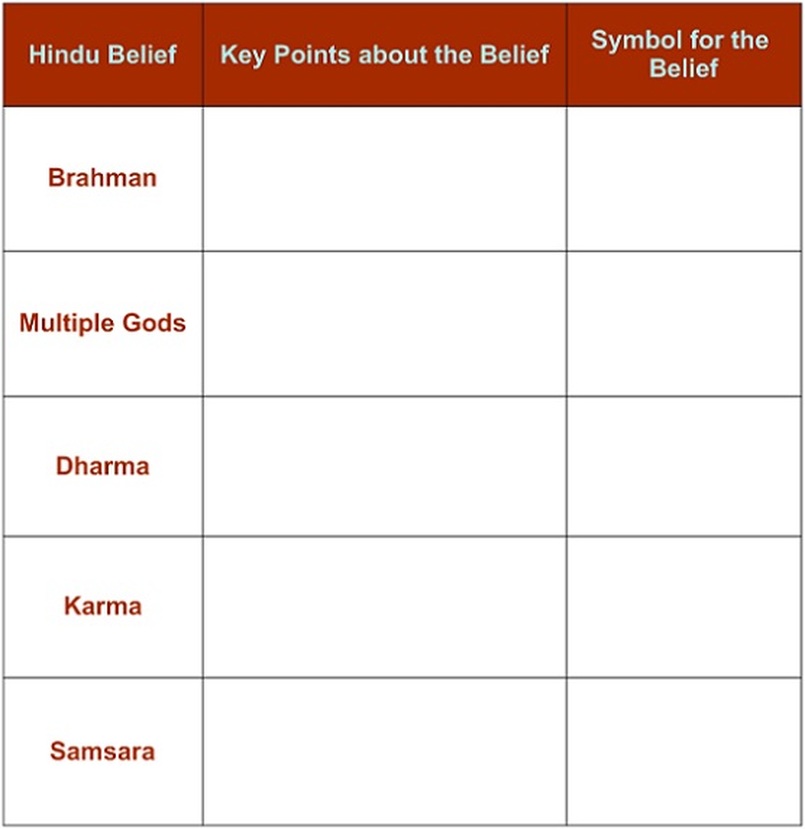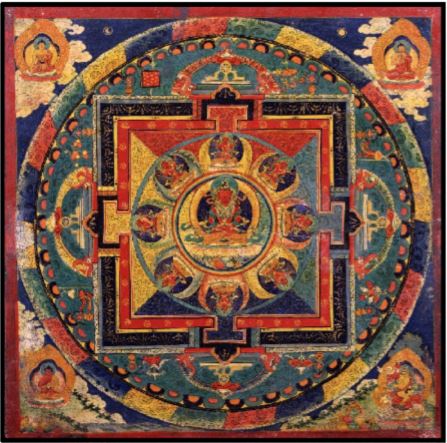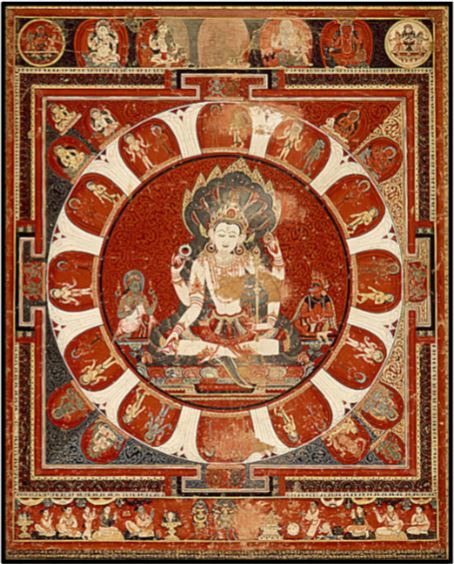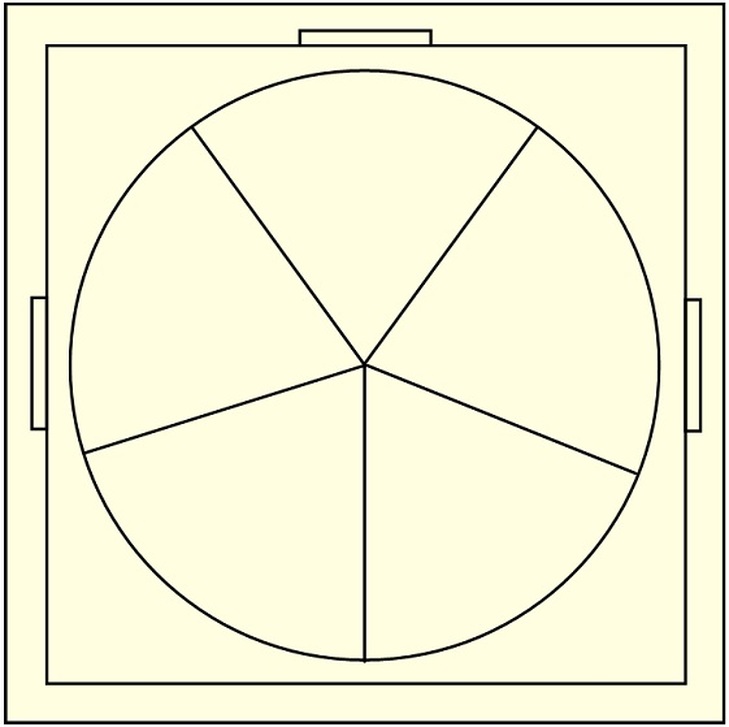India Aryan Civilization Activities
|
The Caste System
Before completing the chart below, watch the video to the right and discuss the following questions with your partners. Then, print a copy of the questions and compose thoughtful responses. As always, please write complete sentences and do your best with spelling, punctuation, and grammar. Thank you! How did the Aryans determine one's social class? What determines your social class today? How did the Aryans distinguish the different people? Today, how can we tell what class people belong to? The Aryans could not change their class. Can you change yours? If so, how? Do you feel like you are fulfilling a certain duty to society? What factors will determine your destiny? |
|
The Caste System: Use the charts below to compare the castes of India with our social classes. In the chart, fill in the types of people that would belong in each level for both societies.
Hinduism: Hinduism is the religion of the majority of people in India and Nepal. It also exists among significant populations outside of the sub-continent and has over 900 million practitioners worldwide. Before you get started with your reading about Hinduism, print out the chart below and complete the chart as you read.
|
Defining Hinduism: Hinduism is an ancient religion whose origins predate recorded history. In some ways, Hinduism is the oldest living religion in the world. Some elements of Hindu worship stretch back many thousands of years. Unlike most other religions, Hinduism has no single founder, no single scripture, and no commonly agreed set of teachings. Throughout its extensive history, there have been many key figures teaching different philosophies and writing numerous holy books. For these reasons, writers often refer to Hinduism as "a way of life" or "a family of religions," rather than a single religion.
|
|
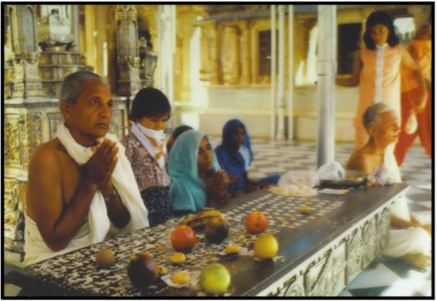
Basic Hindu Beliefs: Its most sacred scriptures are the Vedas. The word, "veda," comes from Sanskrit, the ritual language of Hinduism, and means "knowledge." The Vedas began as an oral tradition, and modern scholars have speculated that they date back as far as 6500 BCE. Historians believe that the Vedas were written down around 1000 BCE or earlier. Other elements of Hinduism - such as sacred symbols and the worship of certain Gods - can be traced back to the seventh century BCE. Partly because of the vast array of practices and beliefs found within it, however, Hinduism resists easy definition.
The term "Hindu" is derived from the main river system of northwest India, the Sindhu. Sindhu is a Sanskrit word used by the inhabitants of the region. However, we refer to the same river as the Indus. The Aryans that invaded the area in the second millennium BCE were probably the first to refer to the people of the region as "hindus." Later, migrants and invaders - the Persians in the sixth century BCE, the Greeks from the 4th century BCE, and the Muslims from the 8th century CE, used the name of this river in their own languages to describe both the land and its people.
The term "Hindu" is derived from the main river system of northwest India, the Sindhu. Sindhu is a Sanskrit word used by the inhabitants of the region. However, we refer to the same river as the Indus. The Aryans that invaded the area in the second millennium BCE were probably the first to refer to the people of the region as "hindus." Later, migrants and invaders - the Persians in the sixth century BCE, the Greeks from the 4th century BCE, and the Muslims from the 8th century CE, used the name of this river in their own languages to describe both the land and its people.
By the end of the activity: You will be able to describe aspects of Hinduism and create a mandala that is representative of Hindu beliefs.
To accomplish that goal: You will learn about the core beliefs of Hinduism.
To demonstrate your knowledge: You will show what you know by completing a graphic organizer explaining Hindu beliefs and creating a mandala that represents those core beliefs.
To accomplish that goal: You will learn about the core beliefs of Hinduism.
To demonstrate your knowledge: You will show what you know by completing a graphic organizer explaining Hindu beliefs and creating a mandala that represents those core beliefs.
|
Step 1: Learning about Basic Hindu Beliefs
Begin by reviewing the video at right. It's a good intro to core Hindu beliefs. Then, look at the pictures below and read the corresponding text to complete the Basic Hindu Beliefs Chart below. Brahman: Brahman is the name for Hinduism's one Supreme God or, more closely, Spirit. Brahman creates, maintains, destroys, and recreates the universe in a never-ending cycle. Everything in the world, including each human soul, or atman, is a part of Brahman. Just like a single drop of water in a great ocean, the atman is both separate from and one with Brahman (God). A Hindu's spiritual goal is to unite his or her soul with Brahman. |
|
Multiple Gods: Hindus are polytheistic. That means that they worship many gods and goddesses, but they believe the gods are all aspects of the one Supreme God, Brahman. Hindus believe that the multiple gods represent the countless different qualities and powers of Brahman. Some Hindu gods have human-like personalities, and others represent such things as success, good luck, and war. Each Hindu person or family may be especially devoted to a particular god or goddess. Three of the most important gods are Vishnu, Shiva, and Brahma (not to be confused with Brahman).
In the picture below are four Hindu gods and goddesses. From left to right, they are the Goddess Sri Vishwaroopa, shown here as containing all the gods within herself; the God Brahman, the creator; the Goddess Durga, the wife of the God Shiva; and the God Vishnu, the preserver, whose job it is to restore balance to the world whenever evil gets the upper hand.
In the picture below are four Hindu gods and goddesses. From left to right, they are the Goddess Sri Vishwaroopa, shown here as containing all the gods within herself; the God Brahman, the creator; the Goddess Durga, the wife of the God Shiva; and the God Vishnu, the preserver, whose job it is to restore balance to the world whenever evil gets the upper hand.
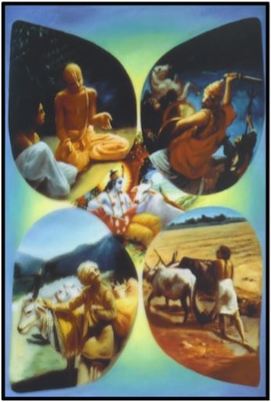
Dharma: Dharma means "to hold or support." Part of dharma relates to sacred (holy) duty or moral responsibility. It is the system of rules and values Hindus follow in their everyday life. Another way to think of dharma is as "the right thing to do" in any situation. Hindus believe in a universal dharma that includes values all Hindus accept and practice, such as nonviolence. However, Hindus also believe they have an individual dharma that they should follow. People's dharmas are determined by different things, such as personality, age, sex, and inherited social class, or varna. Hinduism teaches that when people follow their dharma, they contribute to the harmony and balance of society and the universe.
The picture at left shows people performing the duties of their varna, or caste, thereby honoring the Hindu God Vishnu, seated in the center. From upper left, moving clockwise, these classes include the brahmins (religious scholars), the kshtryiyas (lawmakers and warriors), the shudras (laborers), and the vaishyas (merchants).
The picture at left shows people performing the duties of their varna, or caste, thereby honoring the Hindu God Vishnu, seated in the center. From upper left, moving clockwise, these classes include the brahmins (religious scholars), the kshtryiyas (lawmakers and warriors), the shudras (laborers), and the vaishyas (merchants).
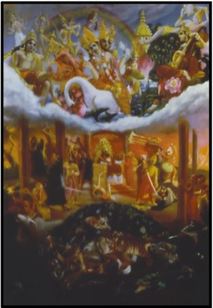
Karma: Hindus believe that karma is the sum of good and bad actions a human soul, or atman, carries with it from life to life. They believe that when people die, the soul leaves the body and is reborn into another body. Hinduism teaches that people's good and bad actions in one life influence their destiny in future lives. In Hinduism, karma determines whether a soul is reborn as a human or an animal, into a rich family or a poor one, and some of the things a person will experience in each lifetime. For example, Hindus believe that a person who steals in this life may be robbed in a future life, or that someone who harms animals may be reborn as an animal.
The picture at right shows the different levels of existence into which people can be reborn, depending on their past actions, or karma.
The picture at right shows the different levels of existence into which people can be reborn, depending on their past actions, or karma.
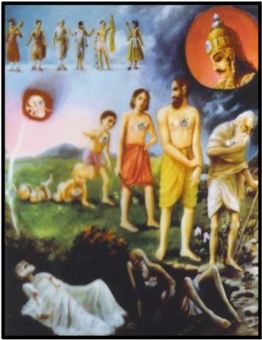
Samsara: In Hinduism, samsara is the continuous cycle of birth, death, and rebirth. The process of rebirth is sometimes referred to as reincarnation. The goal of a Hindu's life is to be released from samsara and united with the Supreme God, Brahman. Hindus call this release moksha and it is achieved after a person's soul has lived through many lifetimes. Hindus achieve moksha by following the path of dharma, balancing their karma (both good and bad actions), worshiping the Gods faithfully, and having a direct and personal experience of God by following certain spiritual practices.
The picture at left shows a human's progress through life stages, ending with death and then rebirth in a different body.
The picture at left shows a human's progress through life stages, ending with death and then rebirth in a different body.
Hindu Beliefs: Print a copy of the chart below. On your chart, you may bullet-point the Hindu beliefs you just read about. By creating a symbol that represents each Hindu belief, you will prepare for success on the next activity, for which you will create a Mandala of Hindu beliefs.
|
Step 2: Design and Create a Mandala
In Sanskrit, Mandala means "circle." Mandalas are circular diagrams that originated with Hinduism and are used in both Hinduism and Buddhism to increase spiritual awareness. Hindu mandalas can range from the very simple to very complex. Mandalas symbolize the cyclical nature of the universe - birth, life, death, re-birth - and people often use mandalas as a way to focus themselves during meditation. Brainstorming Ideas for a Mandala of Hindu Beliefs: To analyze the relationships among Hindu beliefs, work with one or two partners to answer the following questions. However, the mandala you create should be all your own. 1. What are some ways in which the basic beliefs of Hinduism are related to one another? 2. Your mandala should show the relationships among the Hindu beliefs. For example, the symbol for karma could be placed next to and before the symbol for samsara, indicating that people's actions in one life affect the kind of life into which they are reborn. Use the printable template below to brainstorm ideas about what symbols you will use and how you will place them on your mandala. 3. Lastly, write 4 or 5 sentences that explain how your mandala symbolizes the relationships between Hindu beliefs. Now, print out this template and use it to sketch out a design for a Mandala of Hindu beliefs, thereby further enhancing your understanding of Hinduism. Once you've completed this rough draft, transfer your work onto a larger piece of poster paper. As always, be creative and artistic. |

